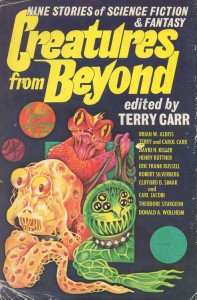Book Review: Creatures from Beyond edited by Terry Carr
This 1975 speculative fiction anthology has the theme of monsters from outside human experience. The question of what lies in the outer darkness has haunted humanity since we developed imaginations. These nine stories look at the possibilities, from implacable enemies, to beings a lot like us in the end.
“The Worm” by David H. Keller is set in a remote Vermont valley that has become depopulated, leaving only an old miller. He no longer runs the millstone, but one night he notices a grinding vibration…A canny and stubborn man against a seemingly inevitable devourer, with a mounting feeling of dread.
“Mimic” by Donald A. Wollheim involves insects that have evolved protective camouflage to live among humans. This story doesn’t have much actually happen in it (unlike the 1997 movie very loosely based on it) with the really chilling moment being when the narrator realizes that the insects aren’t the only creatures that have learned new mimicry tricks.
“It” by Theodore Sturgeon has the distinction of being the inspiration for no less than four independently created comic book characters (Solomon Grundy, the Heap, Man-Thing and Swamp Thing.) It’s a horrific tale of a human corpse that somehow has been animated by hot molds and unknown factors; it stumbles around the woods trying to satisfy its curiosity in destructive ways. And now it wants to learn about humans….very strong last sentence.
“Beauty and the Beast” by Henry Kuttner has a greedy, small-minded man discover the wreck of a spaceship that’s been to Mars. Inside, he finds some seeds and a jeweled egg, and decides to try them out to make a profit. This is of course not the best idea he’s ever had. Genre-savvy readers will spot the twist coming a mile away.
“Some are Born Cats” by Terry and Carol Carr was chosen, as the editor admits, because it’s a sentimental favorite, the first he co-wrote with his wife. Two teens realize that the girl’s cat is not actually a cat, but an alien. Happy ending all around.
“Full Sun” by Brian W. Aldiss takes place in the far future, when humanity, served by its faithful robots, has retreated to shining cities, and the wilderness areas are infested with werewolves. A hunter from the city is tracking down a particularly dangerous werewolf, but he may have more than one enemy in the forest. Interesting last minute perspective twist.
“The Silent Colony” by Robert Silverberg is told entirely from the viewpoint of the creatures, aliens who’ve occupied the outer planets, and now notice that some of their kind are on Earth already. But why won’t the colonists communicate? Short.
“The Street That Wasn’t There” by Clifford D. Simak and Carl Jacobi is their only collaboration. A retired professor suddenly notices that his daily walk took a few minutes less than usual, and discovers that an entire street has vanished from the town. The “creature” in this case is an entire alternate universe that’s trying to superimpose itself over ours.
“Dear Devil” by Eric Frank Russell closes out the volume with a friendly Martian exiling himself to Earth. Humanity has nearly wiped itself out with nuclear and germ warfare, and the few survivors have reverted to tiny tribes at best. Fander, despite his fearsome appearance, is a poet, and moved by a thing of beauty, helps the humans bring themselves back from the brink of extinction. The Fifties sexism is strong in this story. Boys are naturally interested in mechanics, engineering and exploring; girls are delicate, and naturally interested in dolls. This holds true across species lines here! It weakens an otherwise decent story.
The Silverberg story is the weakest, and I suspect it was included to fill an exact number of pages. The Wollheim and Sturgeon stories are the best here. Check your library or used bookstore.

